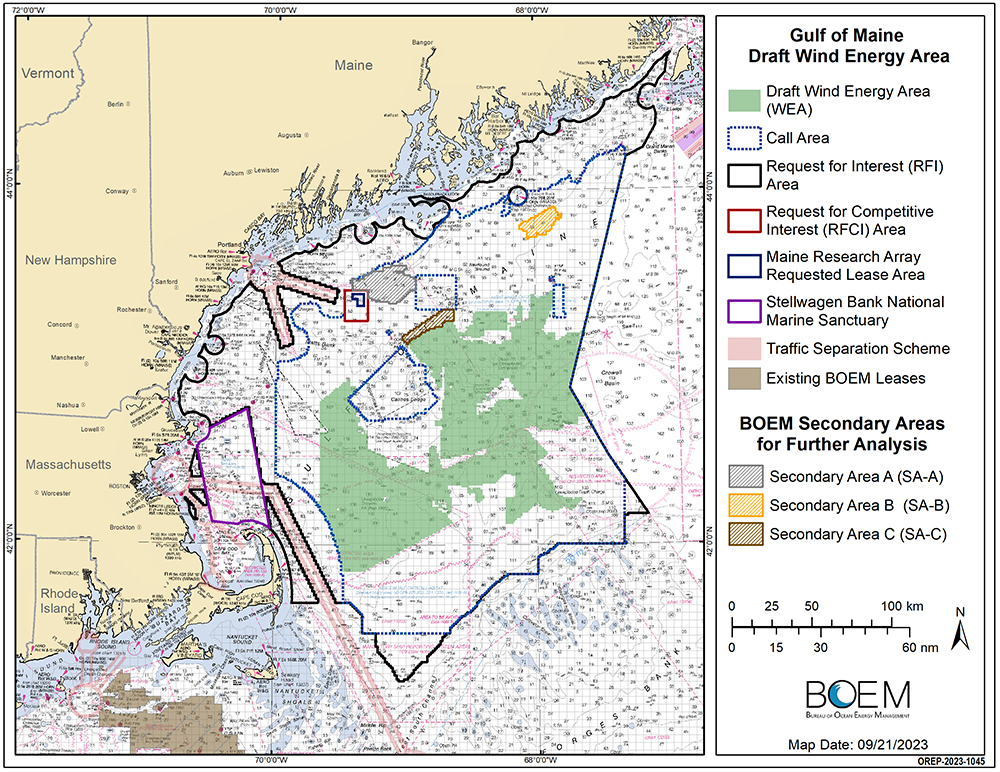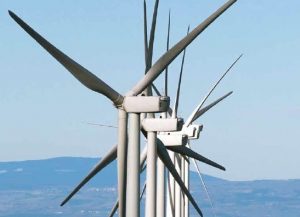 As part of the Biden-Harris administration’s goal of deploying 30 GW of offshore wind-energy capacity by 2030 and 15 GW of floating offshore wind by 2035, the Bureau of Ocean Energy Management (BOEM) recently identified a Draft Wind Energy Area (WEA) in the Gulf of Maine, opening a 30-day public review and comment period.
As part of the Biden-Harris administration’s goal of deploying 30 GW of offshore wind-energy capacity by 2030 and 15 GW of floating offshore wind by 2035, the Bureau of Ocean Energy Management (BOEM) recently identified a Draft Wind Energy Area (WEA) in the Gulf of Maine, opening a 30-day public review and comment period.
The Draft WEA covers about 3,519,067 acres offshore Maine, Massachusetts, and New Hampshire, ranging from around 23-120 miles off the coast. A map of the Draft WEA is on BOEM’s Gulf of Maine webpage.
“BOEM will continue to prioritize a robust and transparent planning process, including engagement with Tribal governments, federal and state agencies, the fishing community and other ocean users,” said BOEM Director Elizabeth Klein. “BOEM strives to minimize potential impacts and will continue working hard to finalize offshore areas that have strong resource potential and the fewest environmental and user conflicts.”
President Biden’s Investing in America agenda is growing the American economy from the middle out and bottom up — from rebuilding infrastructure, to driving more than $500 billion in private sector manufacturing and clean-energy investments in the United States, to creating jobs and building a clean-energy economy that will combat the climate crisis and make communities more resilient.
The Gulf of Maine has significant opportunities for offshore wind-energy development, which will create good-paying jobs and new economic activity. Due to the deep waters within the Gulf of Maine, these areas are also an opportunity to accelerate U.S. leadership in floating technologies.
Since the start of the Biden-Harris administration, BOEM has approved the nation’s first four commercial scale offshore wind projects, held four offshore wind lease auctions — including a record-breaking sale offshore New York and the first-ever sale offshore the Pacific and Gulf Coasts, initiated environmental review of 10 offshore wind projects, and advanced the process to explore additional wind energy areas in Oregon, Gulf of Maine, and Central Atlantic. The department has also taken steps to evolve its approach to offshore wind to drive toward union-built projects and a domestic based supply chain.
The Draft WEA has a capacity of more than 40 GW, which exceeds the current combined offshore wind-energy planning goals for the Gulf of Maine states: 10 GW for Massachusetts and 3 GW for Maine. Future adjustments to the Draft WEA will likely be made after incorporating feedback during the comment period, while striving to retain sufficient area to meet the Gulf of Maine states’ planning goals.
To identify the Draft WEA, BOEM worked collaboratively with the National Oceanic and Atmospheric Administration’s National Centers for Coastal Ocean Science to develop an ocean planning model that identifies and minimizes conflicts with coastal and marine resources and ocean users. BOEM also met with and incorporated feedback from Tribes, fishers, and the public to refine the model and inform the potential offshore locations that appear most suitable for floating offshore wind energy development.
The Draft WEA avoids Lobster Management Area 1 and all North Atlantic Right Whale Restricted Areas. The Draft WEA also avoids other important fishing areas and habitats, including important groundfish areas east of the Western Gulf of Maine Closure and within the 10-kilometer buffer from Georges Bank, Platts Bank, Parker Ridge, and Three Dory Ridge. In response to initial conversations with Tribal Nations within Maine, the Draft WEA strives to avoid a majority of the historic and present fishing grounds of those Tribes. BOEM will continue to consult with all Tribal Nations and other stakeholders who have an interest in the region to understand their concerns with potential offshore wind energy development and minimize conflicts.
BOEM also seeks comments on whether to add all or parts of three secondary areas identified for additional analysis but not part of the Draft WEA.
During the 30-day public comment period that began October 19, 2023, BOEM will hold a series of public meetings to outline data and information used to inform the Draft WEA and to discuss next steps.
To comment on the Draft WEA go to regulations.gov and search for docket number BOEM-2023-54. BOEM will accept comments through 11:59 p.m. ET, November 20, 2023.
MORE INFO www.boem.gov/renewable-energy/state-activities/maine/gulf-maine



























